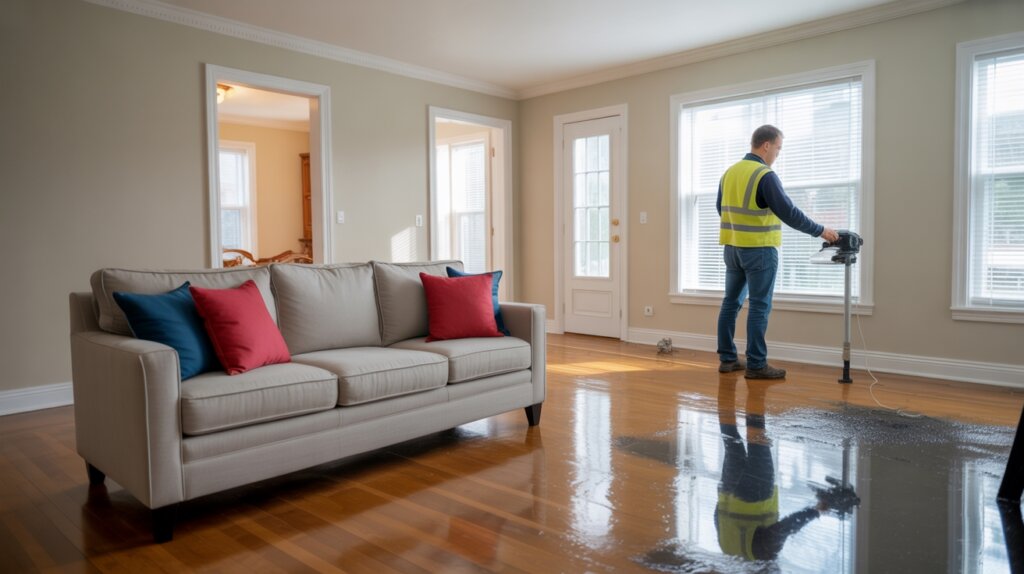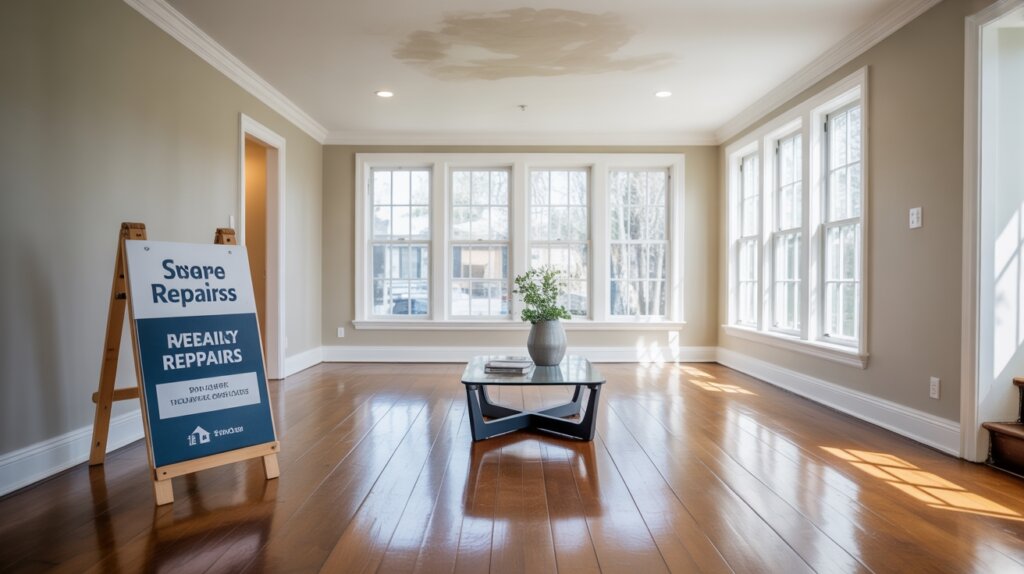Selling a house with water damage is tough. Buyers often hesitate because they worry about hidden costs and future repairs. You need a plan to overcome these challenges and still make a quick sale.
Water damage can scare off even serious buyers. It lowers your home’s value and slows down the selling process. Many sellers feel stuck and unsure how to move forward.
The best strategy to sell a house with water damage fast is to be transparent, price it right, and market to the right buyers. You can attract investors or buyers willing to fix problems if you highlight the potential and show honesty.
Strong preparation and clear communication make all the difference. This blog will guide you through every step to sell your water-damaged house quickly and with less stress.
Key Takeaways
- Disclose all water damage honestly and provide buyers with inspection reports, repair receipts, and before-and-after documentation.
- Price the home competitively based on its current condition and recent comparable sales in your area.
- Complete essential repairs and professional remediation to build buyer confidence and prevent future issues.
- Market the home with professional photos, virtual tours, and highlight its best features to attract more interest.
- Target cash buyers or investors willing to purchase as-is for a quick, hassle-free closing.
Assessing the Extent of Water Damage

To assess water damage, you must first find out how serious the problem is. A moisture inspection with special tools checks for hidden dampness. Water damage is often not visible on the surface. Understanding the property’s tax basis through step-up in basis can help you evaluate the true cost and potential profit when selling after repairs. Certified water damage experts can give you a complete evaluation.
They provide a detailed report of the damage. If you have this report, you will understand the repairs needed. Clear documentation of the problem builds trust with buyers. It also helps speed up the selling process. If you show honesty about the damage, you make your property more attractive to buyers. Additionally, reviewing disclosure forms ensures you are transparent about the extent of the damage, which is crucial for legal compliance and buyer confidence.
Identifying the Source of the Problem
To sell a home with water damage, you must first find where the water is coming from. You cannot fix the problem without knowing its source. Identifying the cause helps you move forward with repairs and selling.
Common sources include roof leaks, broken pipes, or basement seepage. Gutters that do not drain well can also cause damage. If you are unsure, a professional plumbing inspection may help.
Water filtration systems can sometimes leak and cause hidden problems. If you notice unusual moisture, check these systems closely. Early detection prevents bigger issues later.
Understanding liens and their impact can also be beneficial when addressing water damage issues, as unresolved liens may complicate the sale process. Buyers need clear answers about water damage.
If you know the cause, you can explain it with confidence. This honesty can build trust during negotiations. Additionally, being aware of title issues can help you address any legal complications that might arise during the sale.
Repairing Water Damage Before Listing

Repairing water damage before listing your home is important. Fixing these issues protects your home’s value and attracts buyers. If you repair damage early, you can avoid bigger problems later. Addressing water damage early safeguards your home’s value, prevents future issues, and makes your property more appealing to potential buyers.
Professional water damage restoration is often necessary. Experts can find hidden moisture and fix structural issues. If you hire certified professionals, you reduce the risk of future damage. Proper documentation of repairs can also serve as proof of marketable title, reassuring buyers about the property’s condition. Having a clear record of repairs can also help prevent potential foreclosure issues down the line.
Mold removal is also very important. Untreated mold may spread and harm health, which can scare buyers away. Proper mold cleanup keeps your home safe.
Cosmetic repairs help your home look its best. If you repaint walls or replace damaged flooring, your home will look clean and fresh. High-quality repairs reassure buyers and can help you sell faster.
Disclosing Water Issues to Potential Buyers
You need to be upfront about any water issues when selling your home, as legal disclosure requirements protect both you and the buyer. Honest communication not only keeps you compliant but also builds trust with potential buyers. By addressing these concerns early, you set the stage for smoother negotiations and a more powerful sale.
Considering market value can also help you determine the best timing and approach for selling, especially when water damage affects the property’s worth. Additionally, working with a knowledgeable real estate agent can ensure you navigate disclosure laws effectively and present your property in the best light.
Legal Disclosure Requirements
Legal disclosure rules require honesty when selling a house with water damage. Sellers must tell buyers about any water problems, no matter how small. This is necessary even if the damage happened in the past.
Failure to disclose water issues can cause serious trouble. You could face lawsuits, lose the sale, or pay fines if you hide the truth. Full disclosure helps avoid legal and financial risks.
Sellers should also mention if water damage led to mold or structural issues. Some states have different rules, so you should check local laws before selling. If unsure, ask a real estate agent or lawyer for help.
Written disclosures protect you and keep the sale process smooth. Honest communication builds trust with buyers and makes disputes less likely. Clear information helps everyone understand the property’s condition.
Building Buyer Trust
Being honest about water damage helps buyers trust you. Clear disclosure prevents misunderstandings and future arguments. Sharing repair details and insurance steps shows you are responsible.
You should give buyers receipts and inspection reports. Providing documents from your insurance claim builds more confidence. If possible, offer a transferable warranty.
Explain any professional mold prevention steps you took. You can also encourage buyers to get their own inspections. This approach helps you build trust quickly.
Documenting Repairs and Improvements

You should always document repairs and improvements after water damage. Buyers want proof that the problems were fixed correctly. Clear records make it easier for buyers to trust your property.
Keep all invoices, receipts, and inspection reports in one place. Include before-and-after photos to show the changes. If you used insurance, save claim approvals and related letters.
Organized paperwork reassures buyers that you did not hide any issues. If you show detailed records, buyers may feel more confident making an offer. Proper documentation also helps with any future insurance needs.
Additionally, evaluating your home’s value can help you set realistic expectations and price your property competitively, making it more attractive to cash buyers. Utilizing a streamlined process by providing comprehensive documentation can expedite the sale and appeal to quick-closing cash buyers.
Setting a Realistic Asking Price
A realistic asking price attracts buyers and reflects the true value of a home with water damage. The right asking price helps sell a house with water damage quickly. Buyers expect a lower price because of repairs. If you price your home too high, you may not get offers.
You should review recent sales of similar homes in your area. Adjust your price to reflect the damage and needed repairs. A real estate agent can help you choose a smart price. Being open to adjustments can also facilitate a faster sale.
If market demand changes, adjust your price. Listen to feedback from buyers and open houses. Sellers who stay flexible are more likely to close a sale.
Highlighting the Home’s Positive Features
Highlighting your home’s best features can attract buyers, even if there is water damage. Focus on what makes the home special. Serious buyers may overlook flaws if positives stand out.
A large living area or modern kitchen adds appeal. Prime locations can outweigh minor issues. Good curb appeal creates a strong first impression for visitors.
Professional photos should highlight bright rooms and special details. New upgrades or energy-saving systems add extra value. Staging the home can draw attention to its best qualities.
If you mention water damage honestly, buyers may see the home’s true potential. Highlighting positives helps present your property as a smart choice. Buyers are more likely to consider the home if benefits are clear.
Additionally, emphasizing timing advantages such as quick sales through cash buyers can make your property more appealing despite existing issues.
Staging the Property for Maximum Appeal
To attract serious buyers, you’ll want to stage the home so its best spaces truly stand out. Focus on highlighting unaffected living areas, choose neutral decor, and maximize both lighting and cleanliness to create an inviting atmosphere. These simple adjustments help buyers see the property’s full potential, even if some areas have water damage.
Additionally, presenting a realistic home value can make your property more appealing to cash buyers seeking fair deals. It’s also important to price your home correctly, as overpricing can deter buyers and extend the selling process unnecessarily.
Highlight Unaffected Living Spaces
Unaffected living spaces help show your home’s best features. These areas give buyers a clear view of what is in good condition. If buyers see clean and well-maintained rooms, they may feel more confident.
Homeowners should deep clean and remove clutter from each room. Proper furniture placement can make the space look larger and more inviting. Natural light should be maximized by opening curtains or cleaning blinds.
You can add simple decorations like fresh flowers or tasteful pieces of art. Clean and pleasant spaces feel welcoming. If you provide clear documentation of water damage repairs, buyers may trust your efforts more.
If you use these steps, unaffected areas will look their best. This approach shows that you care for the property and take issues seriously.
Use Neutral Decor Choices
Neutral decor helps your home appeal to more buyers. It uses colors like light gray, white, or beige. These colors make rooms look clean and open.
Buyers can imagine their own furniture in a space with neutral colors. If you use simple furniture and minimal decorations, rooms look fresh. Neutral decor also hides flaws, such as past water damage, from attention.
Photos of neutral rooms look good online and attract more interest. If you want to sell quickly, neutral decor can help. This approach helps buyers focus on the home’s best features.
Optimize Lighting and Cleanliness
Good lighting and cleanliness can help your home look its best, even after water damage. Bright, clean spaces make buyers feel comfortable. These steps can create a positive first impression.
Open all blinds and curtains to let in sunlight. Natural light makes rooms look bigger and more inviting. If sunlight is limited, use bright, energy-saving bulbs.
Clean windows so more light enters the home. Wash carpets and floors to remove any stains or smells. Declutter rooms to show more space.
If odors remain, use mild air fresheners. A clean and fresh-smelling home shows you have cared for the property. Buyers notice these details and may feel more confident about your home.
Marketing to Investors and Flippers
Investors and flippers often look for homes with water damage because they see profit in repairs. Marketing should show the property’s potential for a good return. If you want to attract these buyers, share honest details about the damage and repairs. Highlight any water damage restoration work already done. This shows you have taken steps to lower risks.
Always provide full legal disclosure about the property’s history and fixes. Listing descriptions should use phrases like “fix-and-flip opportunity” or “value-add project.” These terms appeal to investors looking for projects. If you tailor your message, you will interest buyers who are not afraid of repairs. Emphasizing the property’s potential for appreciation can also attract investors seeking long-term gains.
Selling As-Is to Cash Buyers
You can sell a water-damaged house fast by selling as-is to cash buyers. This method lets you avoid making repairs. Cash buyers often buy homes that need work, including those with water damage.
These buyers do not require you to fix or upgrade anything. If you choose this option, you can close the sale in just a few days. Cash offers usually do not fall through at the last minute.
Buyers will manage the water damage restoration themselves. You do not need to wait for insurance claims or negotiate repairs. If you want a quick, simple sale, selling as-is to a cash buyer is a good choice.
Working With Experienced Real Estate Agents
Working with experienced real estate agents helps you sell a house with water damage more easily. They understand how to handle homes with past issues. Agents can guide you through the selling process step by step.
An agent can help you disclose any water damage clearly. If you have completed repairs, they know how to highlight this to buyers. They can also recommend trusted repair professionals if more work is needed.
Agents use their market knowledge to set the right price. If buyers have concerns, your agent can address them honestly. They will negotiate on your behalf and handle paperwork correctly.
If you want a quicker and safer sale, an experienced agent is a smart choice. They reduce your risk and help you get better results. Even with water damage, you can sell your home successfully with their help.
Offering Incentives to Attract Buyers
Offering incentives is a smart way to attract buyers, especially if your house has water damage. Incentives can make your property more appealing and help it sell faster. Buyers may act quickly if you offer extra value.
You could cover some or all of the buyer’s closing costs. A home warranty can give buyers peace of mind. If needed, offer a repair credit so buyers can handle water damage after the sale.
Consider including popular appliances or furniture in the deal. You might also pay for professional cleaning or moving services. These options can give your property an edge in a tough market.
Using Professional Photography and Virtual Tours
Professional photography and virtual tours help show your home at its best, even if there is water damage. Skilled photographers use lighting and angles to highlight good features and hide flaws.
High-quality photos make your home look more appealing online. Professional photos and virtual tours highlight your home’s strengths, making it look appealing online—even if there’s water damage.
Virtual tours allow buyers to explore your home’s layout from anywhere. These tours keep buyers interested and let them see the flow of the house. If buyers cannot visit in person, virtual tours give them a clear view.
Drone footage and aerial photos show the outside of your property and the neighborhood. These tools can draw attention away from any inside issues. If used well, they help buyers see the whole value of your home.
Good visuals attract more serious buyers, even if there are problems. If you invest in these tools, your home can stand out in the market. Clear and inviting pictures often spark more interest and viewings.
Navigating Buyer Inspections and Negotiations
Buyers will carefully inspect your home, especially if there has been water damage. They may bring in their own experts to assess the repairs. You should be ready for these inspections.
Always share all details about past repairs and provide documents as proof. Receipts and warranties from water damage or mold work help build trust. Inspection reports from qualified contractors are also useful.
If buyers have questions, answer them clearly and quickly. You may need to lower your price if big repairs are still needed. If repairs are unfinished, offering credits instead of fixing them yourself can help negotiations.
Conclusion
If homeowners want to sell a house with water damage quickly, they should act strategically. Taking care of repairs, providing documentation, and being honest about issues can help build buyer trust. If sellers follow these steps, they may increase their chances of a faster sale.
If traditional buyers are hesitant, companies that buy houses for cash can be a good option. These companies often purchase homes as-is, which can save time and effort. If speed and convenience are important, cash buyers offer a simple solution.
If you want to sell your water-damaged house fast, we can help. At Greg Buys Houses, we buy houses for cash, no matter the condition. Contact us today to get a quick, hassle-free offer.

